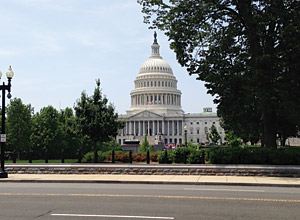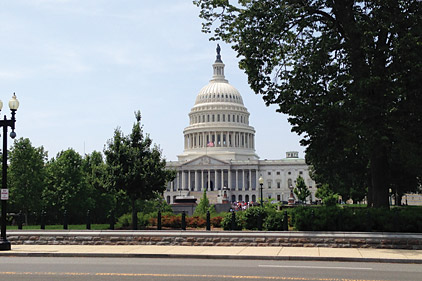
|
| The Home Owner Managing Energy Savings Act of 2013 (HOMES Act) requires $2 billion in federal spending over four years and aims to improve energy efficiency at the residential level by offering substantial rebates to homeowners. |
Arriving hot on the heels of the bipartisan Energy Savings and Industrial Competitiveness Act of 2013 (ESIC), better known as the Shaheen-Portman bill, Reps. David McKinley, R-W.Va., and Peter Welch, D-Vt., introduced the Home Owner Managing Energy Savings Act of 2013 (HOMES Act) — a similar piece of legislation that aims to improve energy efficiency at the residential level through enticing rebates.
The HOMES Act would create the Home Energy Saving Retrofit Rebate program, which would provide $2,000-$8,000 in rebates directly to the consumer, depending on the retrofit project’s total energy savings.
But, unlike the widely-supported Shaheen-Portman bill, which uses federal funds to set up state programs, the HOMES Act requires the federal government to appropriate $500 million each of the fiscal years 2014-2017, causing some industry leaders to worry that the bill’s cost will make it undesirable to fiscally conservative members of the House and Senate.
Home Star Fails
The HOMES Act builds off of Welch’s Home Star Energy Retrofit Act, which he introduced to the House in 2010. The House passed the bill in May of that year, but when it reached the Senate, some organizations raised concerns about the bill, including the Air Conditioning Contractors of America (ACCA), which said it could not endorse the bill because of its unclear and potentially limiting accreditation requirements for contractors.
The bill was also controversial because it dispensed rebates directly to the contractors, who had to apply for the rebate after the work was completed, instead of dispensing the rebate to the homeowner. Though the bill was debated in committee in the Senate, it never went to the Senate floor for a vote.
In March of 2012, an updated version of the Home Star bill was introduced as the Home Owner Managing Energy Savings Act of 2012. While the bill was referred to the House Energy and Commerce Committee and the Ways and Means Committee, it failed to gain further traction under the 112th Congress.
Home Star to HOMES Act
The latest version, HR 2128, addresses many of the controversial issues in the Home Star Act. The bill now specifies that qualifying contractors must be certified by ACCA, Residential Energy Services Network (RESNET), Building Performance Institute (BPI), a “state-based certification program established to carry out state-energy, clean-air, or environmental programs,” or “an equivalent certification program approved by the secretary for this purpose.”
Or, the contractor may employ or utilize subcontractors who must be certified by BPI, RESNET, ACCA, North American Technical Excellence (NATE), the Laborers International Union of North America (LIUNA), a regional or state department of energy weatherization training center, or another approved worker certification program. The contractor must also hold insurance coverage of at least $1 million for general liability and provide a warranty for the retrofit work performed.
Additionally, changes were made to how the rebate is disbursed. In the most recent version of the bill, homeowners may apply for the rebate, though the rebate can be transferred directly to the contractor performing the retrofit work.
Finally, the HOMES Act of 2013 broadly defines a qualified energy-efficiency retrofit as “a retrofit that implements measures, during a rebate-eligible year in the existing principal residence of the homeowner which is located in the U.S., intended to reduce the energy use of such residence.”
This allows the consumer to make upgrades that can include doors, windows, HVAC appliances and equipment, insulation, and other improvements that raise the home’s overall energy efficiency by at least 20 percent.
Industry Shows Support
Guido Zucconi, assistant vice president of congressional affairs for the Air-Conditioning, Heating, and Refrigeration Institute (AHRI), said the HOMES Act has support from much of the HVAC industry, including AHRI, which backed the legislation when it was first introduced in 2012.
“We would prefer a technology-neutral approach like this, where the homeowner gets to pick what they do,” he said. “It’s a creative way to broaden the array of retrofit options for homeowners.”
ACCA, which did not support the original Home Star legislation, also backs the HOMES Act.
“There are two critical changes that make it much better,” said Charlie McCrudden, ACCA’s vice president of government relations. “First, in the HOMES Act, it’s a homeowner’s rebate, which means that the rebate is paid directly to the homeowner, whereas the Home Star legislation would’ve paid the contractor. That meant that the contractor would have to wait for payment, and they may end up waiting several months to get paid.
“Second, it recognizes a much broader range of contractor accreditation, including ACCA’s QA Home Performance Contractor accreditation.”
Jon Melchi, director of government affairs at Heating, Air-
conditioning, and Refrigeration Dis-
tributors International (HARDI), said HARDI is optimistic about the legislation and will continue to monitor its progress as it moves forward.
“We’re always interested in legislation that has to do with the HVAC industry, and we’ll be looking to learn more about the bill as it moves through the legislative process,” he said.
Meanwhile, many other industry organizations, including the Sheet Metal and Air Conditioning Contractors’ National Association (SMACNA), RESNET, and LIUNA expressed their support for the HOMES Act.
“The HOMES Act will provide a much-needed incentive to homeowners to make energy-efficient improvements to their homes,” stated a letter to Welch and McKinley, which was signed by 42 industry and environmental organizations. “It will create jobs as demand for energy-efficient technologies increases and construction workers are put back to work installing those new technologies.”
An Uphill Battle
Despite its support from the industry, passing the HOMES Act may prove to be difficult in the Republican-controlled House.
“There are some big challenges up ahead,” Zucconi admits. “If you look at how Sens. Jeanne Shaheen and Rob Portman did it before, they had a lot of support through federal programs, and now they have grants to help states set up the efficiency incentives. (The HOMES Act) is the old way of doing it, which makes it more effective, but also more expensive to the federal government.”
Melchi agreed that the current price tag attached to the bill is going to hurt its chance of passing, especially with the financial problems currently plaguing the federal government. “I think it’s going to be very challenging for this legislation to pass,” Melchi said. “It’s $500 million per year. There’s going to be some resistance in the House of Representatives.”
SIDEBAR: HOMES Act Rebate Amounts
In the latest version of the HOMES Act, homeowners would receive the following rebate amounts:
• $2,000 for a 20–24 percent reduction in home energy use;
• $3,000 for a 25–29 percent reduction in home energy use;
• $4,000 for a 30–34 percent reduction in home energy use;
• $5,000 for a 35–39 percent reduction in home energy use;
• $6,000 for a 40–44 percent reduction in home energy use;
• $7,000 for a 45–49 percent reduction in home energy use; and
• $8,000 for a 50 percent or more reduction in home energy use.
As of presstime, the HOMES Act was most recently referred to the House Energy and Commerce Committee and the Ways and Means Committee. For more information, visit http://bit.ly/12r8tB1.
Publication date: 7/1/2013
Want more HVAC industry news and information? Join The NEWS on Facebook, Twitter, and LinkedIn today!



Report Abusive Comment